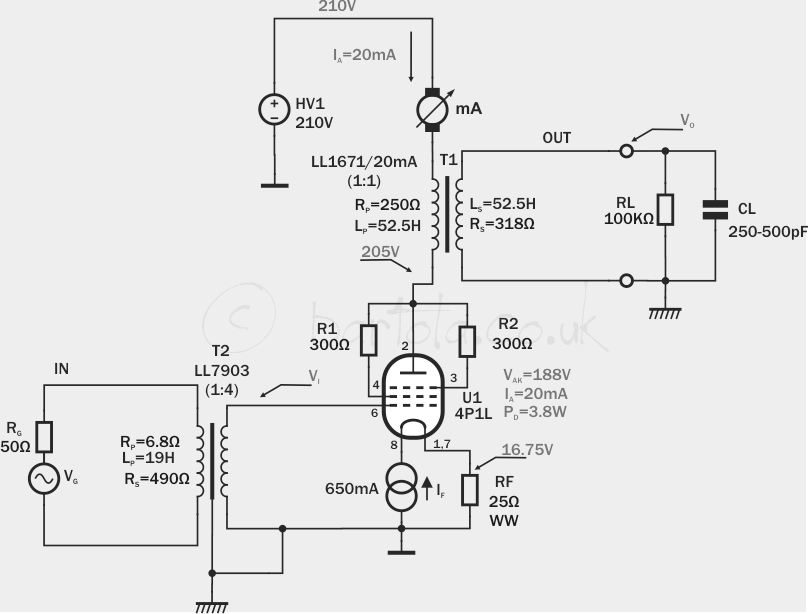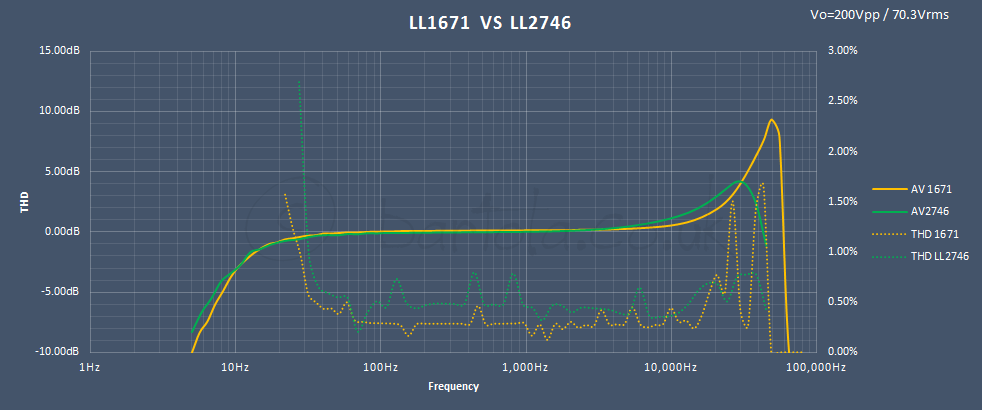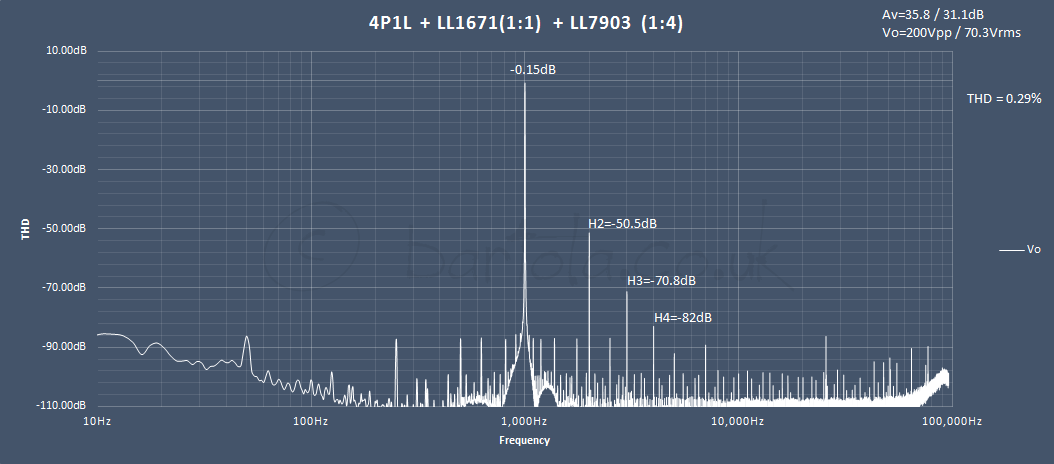801A is lovely, but expect to need -20V or more of bias.
Maybe Va=380V, Ia=30mA, and -23V. But this burns nearly 30W in the bias resistor!
23V x 1,25A = 28,75W (16,8 ohm resistor)
That's a lot of heat.
Maybe you can reduce the anode voltage, and succeed with smaller bias?
I think I would prefer to try some fixed bias, at this level.
Maybe Va=380V, Ia=30mA, and -23V. But this burns nearly 30W in the bias resistor!
23V x 1,25A = 28,75W (16,8 ohm resistor)
That's a lot of heat.
Maybe you can reduce the anode voltage, and succeed with smaller bias?
I think I would prefer to try some fixed bias, at this level.
Hi Bas,
I did some initial tests with starved filaments on a 10Y. Filaments were starved to 1060mA / 5.1V and used a 5 ohm filament resistor. That is less than 6W per filament, manageable.
The anode voltage was 260V and current was about 32mA. I could get 0.03% at 10Vpp and with Vgk at around -5.5V gave sufficient headroom for preamp. It should give about 600 ohms of output impedance with a LL1660 in 4.5:1.
I will try this configuration soon as it won't require a big modification from my current 4P1L
Other option is fixed bias as Rod recommended. I tested his regulator recently and works like a charm!
cheers
Ale
I did some initial tests with starved filaments on a 10Y. Filaments were starved to 1060mA / 5.1V and used a 5 ohm filament resistor. That is less than 6W per filament, manageable.
The anode voltage was 260V and current was about 32mA. I could get 0.03% at 10Vpp and with Vgk at around -5.5V gave sufficient headroom for preamp. It should give about 600 ohms of output impedance with a LL1660 in 4.5:1.
I will try this configuration soon as it won't require a big modification from my current 4P1L
Other option is fixed bias as Rod recommended. I tested his regulator recently and works like a charm!
cheers
Ale
I can confirm that Rod's bias supply / regulator is
working well
Non plus ultra actually (according to my experiences so far)
working well
Non plus ultra actually (according to my experiences so far)
A good negative bias regulator could be a game changer. Part of the reason I use 4P1Ls is that I can use filament bias, so I can get rid of all cathode bypass caps which I loathe.
If a negative supply can be put together that sounds as good as filament bias (and so far nothing has for me) then that opens the door to tubes like the 2a3, 300b and all those other DHTs with greedy filaments and bias voltages over -30v.
But the other reason I use 4P1Ls is the gain of 10. Two tube stages overall in my setup, and that makes a difference to the sound - certainly cleaner in my experience.
So even if a bias supply sounded as good as filament bias, I'd still have to use a tube with a gain of 10. That's not a 2a3 or a 300b. Or use a driver with a gain of over 30. And that's not any DHT I know of that I would want to use.
The 4P1L just conveniently has everything you need for a 2 stage PSE amp in filament bias. It's going to be hard to find anything better in my case. I haven't built anything new in a year - I can't think how to improve on what I have unless I start using higher voltages in the HT, and that's not my plan at all. But as Ale has found, it certainly does work if you're prepared to go down that road. Some nice large tubes with gain around 10. Cost a bit though - 211 has a gain of 12. With sensitive speakers a gain of 8 might work, and then you have the 813 and 814 amongst others.
If a negative supply can be put together that sounds as good as filament bias (and so far nothing has for me) then that opens the door to tubes like the 2a3, 300b and all those other DHTs with greedy filaments and bias voltages over -30v.
But the other reason I use 4P1Ls is the gain of 10. Two tube stages overall in my setup, and that makes a difference to the sound - certainly cleaner in my experience.
So even if a bias supply sounded as good as filament bias, I'd still have to use a tube with a gain of 10. That's not a 2a3 or a 300b. Or use a driver with a gain of over 30. And that's not any DHT I know of that I would want to use.
The 4P1L just conveniently has everything you need for a 2 stage PSE amp in filament bias. It's going to be hard to find anything better in my case. I haven't built anything new in a year - I can't think how to improve on what I have unless I start using higher voltages in the HT, and that's not my plan at all. But as Ale has found, it certainly does work if you're prepared to go down that road. Some nice large tubes with gain around 10. Cost a bit though - 211 has a gain of 12. With sensitive speakers a gain of 8 might work, and then you have the 813 and 814 amongst others.
Last edited:
Or use a driver with a gain of over 30.
Or maybe use a good quality input step-up transformer?
Or maybe use a good quality input step-up transformer?
Well yes, if the impedance feeding it is low enough. In my case it's a DAC - haven't tried it yet. Anyone using this and have recommendations?
But in the case of 2a3 and 300b you'd need more than x2 to get the gain up to a 4P1L.
If gain over 10 is needed in a DHT stage, then two options are to be considered. One is 4P1L as pentode 🙂 and secondly (the one I'm currently using) is using a step-up input transformer. I'm using the LL7903 in my 46 driver with great results. I love its sound. I recently did some experiments with the 4P1L driver using the LL7903 wired in 1:4 step-up:

You can swing the 4P1L to 200Vpp easily with less than 0.3% THD. Nice harmonic distribution as well.
I tried the LL1671 in 1:1 and the LL2746 in 1:2 step-up. The latter can perform much better if wired in 1:1 (recommended by Thomas Mayer from his own designs):

Obviously you can see I didn't bother to add Zobel compensation for the HF peaks above. Practical experience shows that you may even not hear the difference 🙂
Ale

You can swing the 4P1L to 200Vpp easily with less than 0.3% THD. Nice harmonic distribution as well.
I tried the LL1671 in 1:1 and the LL2746 in 1:2 step-up. The latter can perform much better if wired in 1:1 (recommended by Thomas Mayer from his own designs):

Obviously you can see I didn't bother to add Zobel compensation for the HF peaks above. Practical experience shows that you may even not hear the difference 🙂
Ale
Well yes, if the impedance feeding it is low enough. In my case it's a DAC - haven't tried it yet. Anyone using this and have recommendations?
But in the case of 2a3 and 300b you'd need more than x2 to get the gain up to a 4P1L.
Hi Andy,
you can get 36 with a 4P1L with input step-up:

However you pay the price of having Miller impacting heavily. I measured the input capacitance @ mu=9 to be around 176pF for a 4P1L. This will be reflected as 176pf*16 for a 1:4 step up transformer. This is nearly 2,816pF of input load! If you don't have a line-stage, then I don't think it would be any manageable load for your DAC at all.
In my current 46 driver, the 46 has a mu-follower gyrator load and the anode voltage is fixed, therefore is not suffering from Miller in the same way.
Ale
Hello ,
here is a professional solution for the ringing problem from an old Siemens unit ( the 2 sockets in the upper row ) .
Kind regards , Alexander .

here is a professional solution for the ringing problem from an old Siemens unit ( the 2 sockets in the upper row ) .
Kind regards , Alexander .

Ah Ale! This is interesting. Are you using the LL7903 in step-up with the 46? What ratio?
I had a LL1676 in my possession recently but didn't try it out and passed it on.
Then there are all the Cinemag and Jensen offerings and even the Hammond broadcast ones - loads of such transformers.
I had a LL1676 in my possession recently but didn't try it out and passed it on.
Then there are all the Cinemag and Jensen offerings and even the Hammond broadcast ones - loads of such transformers.
Hi Ale,Hi Andy,
you can get 36 with a 4P1L with input step-up:

However you pay the price of having Miller impacting heavily. I measured the input capacitance @ mu=9 to be around 176pF for a 4P1L. This will be reflected as 176pf*16 for a 1:4 step up transformer. This is nearly 2,816pF of input load! If you don't have a line-stage, then I don't think it would be any manageable load for your DAC at all.
In my current 46 driver, the 46 has a mu-follower gyrator load and the anode voltage is fixed, therefore is not suffering from Miller in the same way.
Ale
I measured 4P1L's input capacitance using Morgan's idea: sin wave with series resistor and determine f-3dB. Cinput =1/2pi*f-3dB*R. From my measurements Cinput was about 75pF. If this is correct, we might have a better input load for 1:4 SUT of 1200pF. The question is does this value makes thinks much better?
Maybe a 1:2 SUT would be an acceptable solution.
Best,
Radu
Ah Ale! This is interesting. Are you using the LL7903 in step-up with the 46? What ratio?
I had a LL1676 in my possession recently but didn't try it out and passed it on.
Then there are all the Cinemag and Jensen offerings and even the Hammond broadcast ones - loads of such transformers.
Hey Andy,
I'm using the LL7903 in 1:8 step-up. Only because I'm getting away from not suffering from our friend Mr. Miller. The 46 can drive the 814 to full tilt in this case. I'm very happy with the sound and performance of this beast 😀
Well, any 1:1 good quality interstage gapped at the right current should do the trick here. I won't recommend running the 4P1L below 25mA in this configuration.
Ale
Hi Ale,
I measured 4P1L's input capacitance using Morgan's idea: sin wave with series resistor and determine f-3dB. Cinput =1/2pi*f-3dB*R. From my measurements Cinput was about 75pF. If this is correct, we might have a better input load for 1:4 SUT of 1200pF. The question is does this value makes thinks much better?
Maybe a 1:2 SUT would be an acceptable solution.
Best,
Radu
Hi Radu, interesting findings. Did you loaded the 4P1L to ensure you could see the Miller capacitance impact? Try both ways to ensure you are measuring the right input capacitance.
I'm fine either way, as my 4P1L line stage has sufficient grunge to drive this driver 😉
Ale
Wow...complex little jobbies...old Siemens unit ( the 2 sockets in the upper row )
Ale,
I've measured again the input capacitance.
1. 4P1L at 30mA, -20V , resistive load of 100K, I measured f-3dB= 84kHz, series resistor 22k, resulting a Cinput of 86pF.
2. Now measured 4P1L loaded 100K resistive and 1.25nF capacitive. f-3dB=48kHz, resulting 150pF input
3. Now measured 4P1L loaded 100K resistive and 2.5nF capacitive. f-3dB=31kHz, resulting 233pF input
As the capacitive load increases, the Cinput increases also.
Radu
I've measured again the input capacitance.
1. 4P1L at 30mA, -20V , resistive load of 100K, I measured f-3dB= 84kHz, series resistor 22k, resulting a Cinput of 86pF.
2. Now measured 4P1L loaded 100K resistive and 1.25nF capacitive. f-3dB=48kHz, resulting 150pF input
3. Now measured 4P1L loaded 100K resistive and 2.5nF capacitive. f-3dB=31kHz, resulting 233pF input
As the capacitive load increases, the Cinput increases also.
Radu
Just finished a new version of the 4P1L preamp. A full description, circuit diagram and photos here: 4P1L DHT Preamp Siberian (Gen3) finished! | Bartola Valves
cheers,
Ale
cheers,
Ale
Just finished a new version of the 4P1L preamp. A full description, circuit diagram and photos here: 4P1L DHT Preamp Siberian (Gen3) finished! | Bartola Valves
cheers,
Ale
Hi Ale,
where did you buy 40mA version of LL1660? Is there possible to use LL1660 in ALT V mode to get balanced output?
- Home
- Amplifiers
- Tubes / Valves
- 4P1L DHT Line Stage